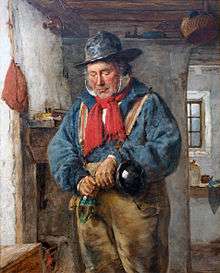Erskine Nicol
| Erskine Nicol | |
|---|---|
 | |
| Born | 3 July 1825 |
| Died | 8 March 1904 (aged 78) |
| Nationality | Scottish |
| Education | William Allan |
| Known for | oil painting |
Erskine Nicol RSA ARA (3 July 1825 – 1904) was a Scottish figure and genre painter.
Career
He was born in Leith on 3 July 1825[1] the eldest son of James Main Nicol and his wife Margaret Alexander.[2]
After initial apprenticeship as a decorator he turned to art. He was a student at the Trustees' Academy, Edinburgh, where he studied with Sir William Allan, and Thomas Duncan.[1] On qualifying he initially taught as an Art Master at Leith Academy.[3]


Nicol taught in Dublin, Ireland, from 1845–50, at the height of the Irish famine, and identified with the oppression of the Irish people and much of his work portrays the injustices inflicted upon the Irish population during the 19th century.[4]
In 1850, he moved to Edinburgh. He lived at 1 Blenheim Place, a fine Georgian flat at the top of Leith Walk.[5] He was made an Associate of the Royal Scottish Academy in 1851 and an Academician in 1859. [1]
Nicol exhibited at the Royal Academy and was made an Associate of the Royal Academy in 1866. He also exhibited at the Royal Hibernian Academy and the British Institution.
In 1862 he left Edinburgh and moved to St John's Wood in London, then in 1864 moved to 24 Dawson Place in west London. He also purchased a studio in Clonave in County Westmeath in Ireland and enjoyed finishing canvases there until ill-health forced him to curtail his travelling. He thereafter used a disused church in Pitlochry to complete his works.[6]
He died at The Dell, Feltham, on 8 March 1904.[1] He is buried with his second wife in Rottingdean.
In 1905 the Royal Scottish Academy held a commemorative exhibition.
Selected works

- Wayside Prayers (1852) Tate Gallery
- Beggar My Neighbour (1855)
- Irish Merry-Making (1856)
- Donnybrook Fair (1856)
- The Perch Fishers (1857)
- The Approach of the Enemy (1859)
- Portrait of Sir William Fettes Douglas (1862) Royal Scottish Academy
- Renewal of the Lease Refused (1863)
- Irish Emigrants Waiting for the Train (1864)
- The Emigrants (1864) Tate Gallery
- A Deputation (1865)
- Collecting His Thoughts (1865) Sheffield Museums
- Both Puzzled (1866)
- A Country Booking-Office (1867)
- Making Pills for the Saxons (1868)
- The Crossroads (1868)
- Steady, Johnnie, Steady (1870)
- Kept In (1871)
- The Missing Boat (1877)
Family
Nicol was twice married: first in 1851 to Janet Watson, who died in 1863, leaving a son (Mr. John Watson Nicol, a painter) and a daughter; second in 1865 to Margaret Mary Wood, who survived him, and by whom he had two sons (the elder, Mr. Erskine Edwin Nicol, a painter) and a daughter. [1]
Notes
- 1 2 3 4 5 Meldrum 1912.
- ↑ http://www.avictorian.com/Nicol_Erskine.html
- ↑ http://www.avictorian.com/Nicol_Erskine.html
- ↑ Erskine Nicol Contemporary Irish Art Archived 6 February 2007 at the Wayback Machine.. Retrieved 4 September 2007.
- ↑ Edinburgh and Leith Post Office Directory 1859-60
- ↑ http://www.avictorian.com/Nicol_Erskine.html
References

- Soden, Joanna. "Nicol, Erskine (1825–1904)". Oxford Dictionary of National Biography (online ed.). Oxford University Press. doi:10.1093/ref:odnb/35235. (Subscription or UK public library membership required.)
External links
| Wikimedia Commons has media related to Erskine Nicol. |